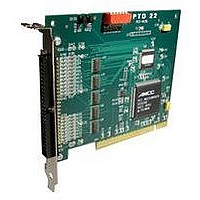PCI-AC51 OPTO 22, PCI-AC51 Datasheet - Page 11

PCI-AC51
Manufacturer Part Number
PCI-AC51
Description
Computers, Interface Cards
Manufacturer
OPTO 22
Datasheet
1.PCI-AC51.pdf
(24 pages)
Specifications of PCI-AC51
Peak Reflow Compatible (260 C)
No
Leaded Process Compatible
No
Lead Free Status / RoHS Status
Contains lead / RoHS non-compliant
Overview
2: Programming with the
PCI-AC51 Toolkit in Windows
To simplify communication to the Pamux bus, you can use Opto 22’s PCI-AC51 Toolkit. This chapter
explains how to use the toolkit.
What Is the PCI-AC51 Toolkit?
The PCI-AC51 Toolkit provides an interface between Pamux stations and application programs
written in Microsoft Visual C++ and Visual Basic 6.0. The toolkit saves you time and effort that would
otherwise be spent learning the intricacies of the Pamux bus structure.
The toolkit is 32-bit Microsoft Windows software, a dynamically linked library called OptoPM32.dll.
The toolkit may be used with Microsoft Visual Basic or Visual C++.
NOTE: Release 2.0 and higher support only the PCI-AC51—not the AC28 and PCI-AC28 adapter cards.
The toolkit performs the following functions:
•
•
•
To use the toolkit in your application program, you need to know the following:
•
•
•
The PCI-AC51 toolkit may be used only with the PCI-AC51 adapter card.
Converts the data returned by Pamux to a form that is easily manipulated in a high-level
language.
Transparently handles input masking on write operations for digital stations.
Performs error checking and returns diagnostic codes.
How to call a subroutine or function from the language you chose for your application
How to tell the toolkit what Pamux command to send by assigning values to parameters
How to interpret the data passed back by the toolkit.
Chapter 2
PCI-AC51 User’s Guide
7
7


















